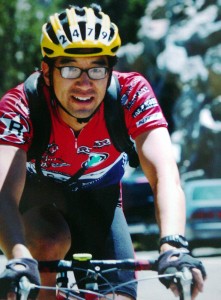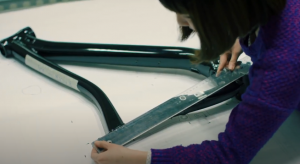Engineering Better Bikes
 If, as Robert Frost penned, the “object in living” is to unite one’s avocation and vocation, Eric Wang has found his sweet spot. An accomplished cyclist and rock climber, the associate professor of mechanical engineering at the University of Nevada, Reno is a leading sports-equipment researcher, probing snowboard biomechanics and the dynamics of human falls. “Luckily, my two sports, cycling and climbing, are complementary in terms of overuse injuries,” jokes Wang, who recently switched from climbing to pedaling while he recovered from an injured shoulder.
If, as Robert Frost penned, the “object in living” is to unite one’s avocation and vocation, Eric Wang has found his sweet spot. An accomplished cyclist and rock climber, the associate professor of mechanical engineering at the University of Nevada, Reno is a leading sports-equipment researcher, probing snowboard biomechanics and the dynamics of human falls. “Luckily, my two sports, cycling and climbing, are complementary in terms of overuse injuries,” jokes Wang, who recently switched from climbing to pedaling while he recovered from an injured shoulder.
Raised in Los Altos, Calif., Wang entered the University of California, Berkeley intending to pursue physics or astronomy. Then a friend suggested mechanical engineering, telling him, “You can always transfer out of engineering if you don’t like it, but you can’t transfer in.” Wang did like it. “In hindsight, I had many of the signs that engineering was right – like working on cars, or taking apart and building things,” he reflects.
After earning a master’s from MIT, Wang, by then a competitive mountain-bike racer, decided to go for a Ph.D. if he could “work on bikes.” He found such a program at the University of California, Davis, where he investigated the quantification and optimization of mountain bike suspension systems. The fascination persists: “I ride my bike and wonder, who the heck built this? It drives me crazy. Every day, I think, how can I make this better?”
In his research and award-winning teaching, Wang’s emphasis is on applications. His biomechanics lab has conducted studies for a host of major companies and propelled improvements in the design of off-road bicycle tires, snowboard bindings, and helmets. (For example, he developed a system for measuring the cooling effectiveness of bike helmets.) His research on climbing ropes explored the effects of friction, twisting, or other real-life situations. “To be a good designer, you have to know the parameters you’re designing for,” he says.
With his undergraduates, he employs gyroscopes, yo-yos, and other toys to help them understand dynamics and the “quirky,” real-life behavior of objects. He also advises UNR’s human-powered vehicle team.
Watch a safety demonstration of UNR’s 2019 ASME Human Powered Vehicle Challenge:
This profile, which first appeared in the January 2014 issue of ASEE Prism magazine, has been updated to reflect Eric Wang’s current position. Click HERE for to read the full article.

Another engineer whose work has helped improve bikes is Sophia Shih. As a product-design engineer at Liv Cycling, a leading global maker of bikes tailored specifically for women, she designs bike frames, manages female bike sizing and fitting knowledge, and creates the company’s sizing strategy aimed at fitting the majority of women around the world.
Shih entered the bike industry in 2011 after earning a bachelor’s degree in mechanical engineering and a master’s of engineering science at National Taiwan University. Specializing in fluid mechanics, she designed a wind-turbine maintenance system for her graduate degree. Her first job out of school was working in the cycling science team for Giant Bicycles, which created Liv Cycling in 2008, focusing on general cycling research and fitting knowledge.
“Observation, creativity and teamwork are very important,” says Shih. “You need to keep observing what products people want for cycling, you need to create the products and transform them from imagination into reality.” In a global company like Liv Cycling, she adds, you also “need to communicate with people all around the world.”
Read her 2018 interview with BikeRadar.com, from which this article was excerpted.
Want more details on how engineers identify and solve bicycle-design problems? Check out this 2014 paper on using sensors to measure strain on the fork, handlebars, and other structures in BMX bikes by a team from the University of Aukland in New Zealand.
Filed under: Special Features
Tags: bicycle design, Eric L. Wang, forces and motion, helmet, Liv cycling Sophia Shih, Mechanical engineering, Sports Engineering, University of Nevada Reno








